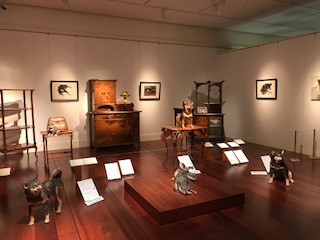Interview with Mio Hashimoto, artist and sculptor.
By Jaqueline B. Ramos*
 When art speaks out for respecting all forms of living beings, the experience of sensing it is unforgettable. And kind of speechless… But to try to put on words the reasons behind the beauty, I talked to Japanese artist and sculptor Mio Hashimoto, who is famous in her country and abroad for her astonishing animal sculptures, and also for teaching and sharing her techniques in books and workshops. Yes Mio san, when you recreate the creatures untouched, people are moved. Thank you for that!
When art speaks out for respecting all forms of living beings, the experience of sensing it is unforgettable. And kind of speechless… But to try to put on words the reasons behind the beauty, I talked to Japanese artist and sculptor Mio Hashimoto, who is famous in her country and abroad for her astonishing animal sculptures, and also for teaching and sharing her techniques in books and workshops. Yes Mio san, when you recreate the creatures untouched, people are moved. Thank you for that!
What’s the main motivation for your work of animals sculptures? How long have you been doing it?
動物の彫刻家として働くことの、最大の動機は何ですか?動物彫刻家としてのキャリア期間はどれくらいですか。
Since I was a little kid, I liked animals. I wanted to be a vet someday. However, things changed after the Hanshin Awaji Earthquake happened. I was 15 years old. A lot of animals disappeared. And I heard about the deaths of a lot of animals. That was my experience of "the sudden disappearance of beautiful lives I love." Medicines never help them get their lives back.
What I loved about animals is the beautiful forms of lives in front of me. I wanted to keep the forms as they were. I wanted to touch them again. That was my reason to be a sculptor who could create them as they are.
I became a professional sculptor when I was 26 years old. That was 12 years ago. I started sculpture when I was a student, 18 years old. That was 20 years ago.
小さい頃から生き物が好きで、獣医になろうと夢見ていました。
しかし15歳の時に、阪神淡路大震災という、大きな地震にあい、たくさんのどうぶつたちの失踪や、死んでしまったお知らせを聞き、「大好きなうつくしい命の存在が、ある日突然消えてしまう」ということを体験しました。
医学では、なくなってしまった命を、取り戻すことはできない。私は、どうぶつたちの何が好きだったかというと、生きている目の前のうつくしいその姿が、とても好きだったのでした。命のそのままの形を残したい、もう一度触れたい、の思いから、どうぶつたちのそのままの姿を残す彫刻家になろうと、決意しました。
26歳の時に彫刻家として独立したので、12年になります。彫刻経験は学生時代から含めると18歳からですので、20年になります。
A lot of animals represented in the sculptures have their names presented. All of them are/were animals that you live/lived with. What about dog Tsuki, was he your pet-friend?
展示されていた彫刻の多くには名前がありました。全て一緒に住んでいたのでしょうか。月くんを飼っていたことはわかったのですが。
 |
| Tsuki |
Those sculptures have models. They were pet dogs of somebody else in Japan. They were stray cats. Some of them live in zoo. One thing in common is that they were loved by somebody else and they have names. The only pet I lived with is Tsuki.
彫刻になってくれたどうぶつたちは、日本のどこかで誰かが飼っている犬だったり、野良猫だったり、動物園にいる子だったりします。みんな人のそばで愛された子たちなので、名前があります。一緒に住んでいたのは、月くんだけです。
About the apes/monkeys presented on your exhibition, are they animals you observed in zoos or sanctuaries? Can you tell about your “relationship” with chimpanzee Max, mandrill Manjuro and orangutan Kyu, for instance?
展示されていた類人猿や猿は動物園や保護区で観察したものですか。例えば、チンパンジーの「マックス」やマンドリルの「マンジュロー」、オラウータンの「キュウ」とあなたの関係性について教えてください。
 |
| Max family (2012) |
Max and Kyu are in Tama zoo, Japan. Kyu is the son of Gypsy, the oldest orangutan in the world. I communicated with the keepers and I tried to recreate them as loyal as possible. I support Borneo Conservation Trust Japan, and I am especially focusing on making orangutan sculptures. Manjuro lives in Higashiyama zoo. I talked with the zoo director in order to put even Manjuro's personality in it.
チンパンジーのマックスくん、オランウータンのキューさんは、日本の多摩動物園で飼育されている子たちです。キューは、ジプシーという、世界最高齢だったオランウータンの息子です。飼育員さんたちと意見を交わし、そのままの姿をできるだけ忠実に再現しました。ボルネオトラスト協会というものがあり、そちらにも参加し、特にオランウータンの制作については力を入れています。
マンドリルのマンジュウロウさんは、東山動物園にいる子です。こちらも、園長さんに話を聞きながら、性格まで忠実に再現しました。
 |
| Kyu (2010-2013) |
Do you believe that your work can help general public to realize and get aware about sentience of animals/non-human beings, their beauty, complexity etc?
あなたはあなたの仕事によって、ヒト以外の動物の感性や美しさ、その複雑さを、一般の人々に対して伝えることができると信じていますか。
Yes. I respect animals and appreciate their beauty. I believe they are more beautiful when they are untouched (as they are). So I believe that if I recreate them as they are, it conveys the excitement or certain impression to general public. I hope that when they see my sculptures, they could be moved as if they see the real creatures.
私は、どうぶつたちをとても尊敬し、そのままの姿が一番うつくしいと信じているので、できるだけ自分の見えた素直な目でどうぶつたちの姿を再現すれば、それがたくさんの人たちにおなじ感動をもって伝わると信じています。私のつくった彫刻のどうぶつたちを見た時、その子そのものに出逢えたような感動を、見る人にも伝えたいと思って制作しています。
To know more about Mio Hashimoto’s work - http://kirinsan.awk.jp/pages_english/pages_e/home.html
Other images of Mio Hashimoto's exhibition
* Environmental journalist (Ambiente-se Comunicação Socioambiental) and Communications Manager for GAP Project International













